Research on the Corrosion Behavior of Q235 Pipeline Steel in an Atmospheric Environment through Experiment
Abstract
:1. Introduction
2. Experiment Procedures
3. Results and Discussion
3.1. Analysis of the Macroscopic and Micro-Morphological Changes of the Sample
3.2. Analysis of Changes in the Atomic Content of Corrosion Products
3.3. Analysis of Corrosion Weight Loss
4. Conclusions
- (1)
- Q235 low-carbon steel in the atmospheric environment of the accelerated corrosion process can be roughly divided into four stages: (1) passivation film corrosion product generation and local shedding, (2) matrix rust layer generation and covering, (3) rust layer accumulation and stacking onto a flat and dense second protective layer, and (4) matrix rust layer breaking through the protective layer continues to grow thicker until shedding.
- (2)
- After pickling passivation treatment of Q235 low-carbon steel in the atmospheric environment of corrosion from passivation film weakness, pitting corrosion gradually develops into comprehensive corrosion with the elongation of time. Rust layer composition gradually transitions from passivation products into iron oxide based on hydroxyl iron oxide. The whole process is “from point to surface” corrosion.
- (3)
- Q235 low-carbon steel corrosion weight loss kinetics is in line with the power function law. The corrosion rate exhibits an increasing, decreasing, and then increasing trend, indicating that Q235 low-carbon steel surface passivation film and passivation film rupture formed after the matrix rust layer play a certain anti-corrosive role.
Author Contributions
Funding
Conflicts of Interest
References
- Saniere, A.; Hénaut, I.; Argillier, J. Pipeline transportation of heavy oils, a strategic, economic and technological challenge. Oil Gas Sci. Technol. 2004, 59, 455–466. [Google Scholar] [CrossRef]
- Sharma, S.K.; Maheshwari, S. A review on welding of high strength oil and gas pipeline steels. J. Nat. Gas Sci. Eng. 2017, 38, 203–217. [Google Scholar] [CrossRef]
- Azevedo, C.R. Failure analysis of a crude oil pipeline. Eng. Fail. Anal. 2007, 14, 978–994. [Google Scholar] [CrossRef]
- Ogundele, G.; White, W. Some observations on corrosion of carbon steel in aqueous environments containing carbon dioxide. Corrosion 1986, 42, 71–78. [Google Scholar] [CrossRef]
- Dwivedi, D.; Lepková, K.; Becker, T. Carbon steel corrosion: A review of key surface properties and characterization methods. RSC Adv. 2017, 7, 4580–4610. [Google Scholar] [CrossRef]
- Katayama, H.; Noda, K.; Masuda, H.; Nagasawa, M.; Itagaki, M.; Watanabe, K. Corrosion simulation of carbon steels in atmospheric environment. Corros. Sci. 2005, 47, 2599–2606. [Google Scholar] [CrossRef]
- Benmoussat, A.; Hadjel, M. Corrosion behavior of low carbon line pipe steel in soil environment. Eurasian Chem.-Technol. J. 2005, 7, 147–156. [Google Scholar] [CrossRef]
- Sheng, K.; Lu, L.; Xiang, Y.; Ma, M.; Wu, Z. Crack behavior in Mg/Al alloy thin sheet during hot compound extrusion. J. Magnes. Alloys 2019, 7, 717–724. [Google Scholar] [CrossRef]
- Vanaei, H.; Eslami, A.; Egbewande, A. A review on pipeline corrosion, in-line inspection (ILI), and corrosion growth rate models. Int. J. Press. Vessel. Pip. 2017, 149, 43–54. [Google Scholar] [CrossRef]
- Luo, P.; Zhang, Y.; Cai, P.; Guo, Z.; Chen, H.; Wang, W. Analysis and countermeasures of natural gas transmission pipeline internal corrosion accidents. Total Corros. Control 2010, 24, 16–21. [Google Scholar]
- Kumar, M.S.; Sujata, M.; Venkataswamy, M.; Bhaumik, S. Failure analysis of a stainless steel pipeline. Eng. Fail. Anal. 2008, 15, 497–504. [Google Scholar] [CrossRef]
- Aljaroudi, A.; Khan, F.; Akinturk, A.; Haddara, M.; Thodi, P. Risk assessment of offshore crude oil pipeline failure. J. Loss Prev. Process Ind. 2015, 37, 101–109. [Google Scholar] [CrossRef]
- Xu, W.-Z.; Li, C.B.; Choung, J.; Lee, J.-M. Corroded pipeline failure analysis using artificial neural network scheme. Adv. Eng. Softw. 2017, 112, 255–266. [Google Scholar] [CrossRef]
- He, B.; Han, P.; Lu, C.; Bai, X. Effect of soil particle size on the corrosion behavior of natural gas pipeline. Eng. Fail. Anal. 2015, 58, 19–30. [Google Scholar] [CrossRef]
- Alcántara, J.; Chico, B.; Simancas, J.; Díaz, I.; Morcillo, M. Marine atmospheric corrosion of carbon steel: A review. Materials 2017, 10, 406. [Google Scholar] [CrossRef]
- Castaño, J.; Botero, C.; Restrepo, A.; Agudelo, E.; Correa, E.; Echeverría, F. Atmospheric corrosion of carbon steel in Colombia. Corros. Sci. 2010, 52, 216–223. [Google Scholar] [CrossRef]
- Xiao, K.; Dong, C.-F.; Li, X.-G.; Wang, F.-M. Corrosion products and formation mechanism during initial stage of atmospheric corrosion of carbon steel. J. Iron Steel Res. Int. 2008, 15, 42–48. [Google Scholar] [CrossRef]
- Mendoza, A.R.; Corvo, F. Outdoor and indoor atmospheric corrosion of carbon steel. Corros. Sci. 1999, 41, 75–86. [Google Scholar] [CrossRef]
- Lu, L.; Liu, X.; Shi, D.; Ma, M.; Wang, Z. Effect of twinning behavior on dynamic recrystallization during extrusion of AZ31 Mg alloy. JOM 2019, 71, 1566–1573. [Google Scholar] [CrossRef]
- das Chagas Almeida, T.; Bandeira, M.C.E.; Moreira, R.M.; Mattos, O.R. New insights on the role of CO2 in the mechanism of carbon steel corrosion. Corros. Sci. 2017, 120, 239–250. [Google Scholar] [CrossRef]
- Dugstad, A. Mechanism of protective film formation during CO2 corrosion of carbon steel. In Proceedings of the CORROSION 98: Research in Progress Symposium Extended Abstracts, San Diego, CA, USA, 22–27 March 1998. [Google Scholar]
- Li, T.; Yang, Y.; Gao, K.; Lu, M. Mechanism of protective film formation during CO2 corrosion of X65 pipeline steel. J. Univ. Sci. Technol. Beijing Miner. Metall. Mater. 2008, 15, 702–706. [Google Scholar] [CrossRef]
- Refait, P.; Grolleau, A.-M.; Jeannin, M.; Rémazeilles, C.; Sabot, R. Corrosion of carbon steel in marine environments: Role of the corrosion product layer. Corros. Mater. Degrad. 2020, 1, 198–218. [Google Scholar] [CrossRef]
- Ma, Y.; Li, Y.; Wang, F. The atmospheric corrosion kinetics of low carbon steel in a tropical marine environment. Corros. Sci. 2010, 52, 1796–1800. [Google Scholar] [CrossRef]
- Ma, Y.; Li, Y.; Wang, F. Corrosion of low carbon steel in atmospheric environments of different chloride content. Corros. Sci. 2009, 51, 997–1006. [Google Scholar] [CrossRef]
- Song, Q.; Wang, X.; Pan, B.; Wan, L. Effect of relative humidity on corrosion of Q235 carbon steel under thin electrolyte layer in simulated marine atmosphere. Anti-Corros. Methods Mater. 2020, 67, 187–196. [Google Scholar] [CrossRef]
- Yu, Q.; Dong, C.-F.; Fang, Y.-H.; Xiao, K.; Guo, C.-Y.; He, G.; Li, X.-G. Atmospheric corrosion of Q235 carbon steel and Q450 weathering steel in Turpan, China. J. Iron Steel Res. Int. 2016, 23, 1061–1070. [Google Scholar] [CrossRef]
- Slaimana, Q.J.; Hasan, B.O. Study on corrosion rate of carbon steel pipe under turbulent flow conditions. Can. J. Chem. Eng. 2010, 88, 1114–1120. [Google Scholar] [CrossRef]
- Liu, X.-Y.; Lu, L.-W.; Sheng, K.; Zhou, T. Microstructure and texture evolution during the direct extrusion and bending–Shear deformation of AZ31 magnesium alloy. Acta Metall. Sin. Engl. Lett. 2019, 32, 710–718. [Google Scholar] [CrossRef]
- Clover, D.; Kinsella, B.; Pejcic, B.; De Marco, R. The influence of microstructure on the corrosion rate of various carbon steels. J. Appl. Electrochem. 2005, 35, 139–149. [Google Scholar] [CrossRef]
- Zhao, M.-C.; Schmutz, P.; Brunner, S.; Liu, M.; Song, G.-L.; Atrens, A. An exploratory study of the corrosion of Mg alloys during interrupted salt spray testing. Corros. Sci. 2009, 51, 1277–1292. [Google Scholar] [CrossRef]
- Brito, V.S.; Bastos, I.; Costa, H. Corrosion resistance and characterization of metallic coatings deposited by thermal spray on carbon steel. Mater. Des. 2012, 41, 282–288. [Google Scholar] [CrossRef]
- Pathak, S.S.; Blanton, M.D.; Mendon, S.K.; Rawlins, J.W. Investigation on dual corrosion performance of magnesium-rich primer for aluminum alloys under salt spray test (ASTM B117) and natural exposure. Corros. Sci. 2010, 52, 1453–1463. [Google Scholar] [CrossRef]
- Altmayer, F. Critical aspects of the salt spray test. Plat. Surf. Fin. 1985, 72, 36–40. [Google Scholar]
- Ahmad, S. Techniques for inducing accelerated corrosion of steel in concrete. Arab. J. Sci. Eng. 2009, 34, 95–104. [Google Scholar]
- Xu, C.; Du, L.; Yang, B.; Zhang, W. Study on salt spray corrosion of Ni–graphite abradable coating with 80Ni20Al and 96NiCr–4Al as bonding layers. Surf. Coat. Technol. 2011, 205, 4154–4161. [Google Scholar] [CrossRef]
- Lyon, S.B.; Thompson, G.E.; Johnson, J.B. Materials evaluation using wet-dry mixed salt-spray tests. In New Methods for Corrosion Testing of Aluminum Alloys; ASTM: Philadelphia, PA, USA, 1992; p. 20. [Google Scholar]
- Palm, M.; Krieg, R. Neutral salt spray tests on Fe–Al and Fe–Al–X. Corros. Sci. 2012, 64, 74–81. [Google Scholar] [CrossRef]
- Cecchel, S.; Cornacchia, G.; Gelfi, M. A study of a non-conventional evaluation of results from salt spray test of aluminum High Pressure Die Casting alloys for automotive components. Mater. Corros. 2019, 70, 70–78. [Google Scholar] [CrossRef]
- Mendoza, A.R.; Corvo, F. Outdoor and indoor atmospheric corrosion of non-ferrous metals. Corros. Sci. 2000, 42, 1123–1147. [Google Scholar] [CrossRef]

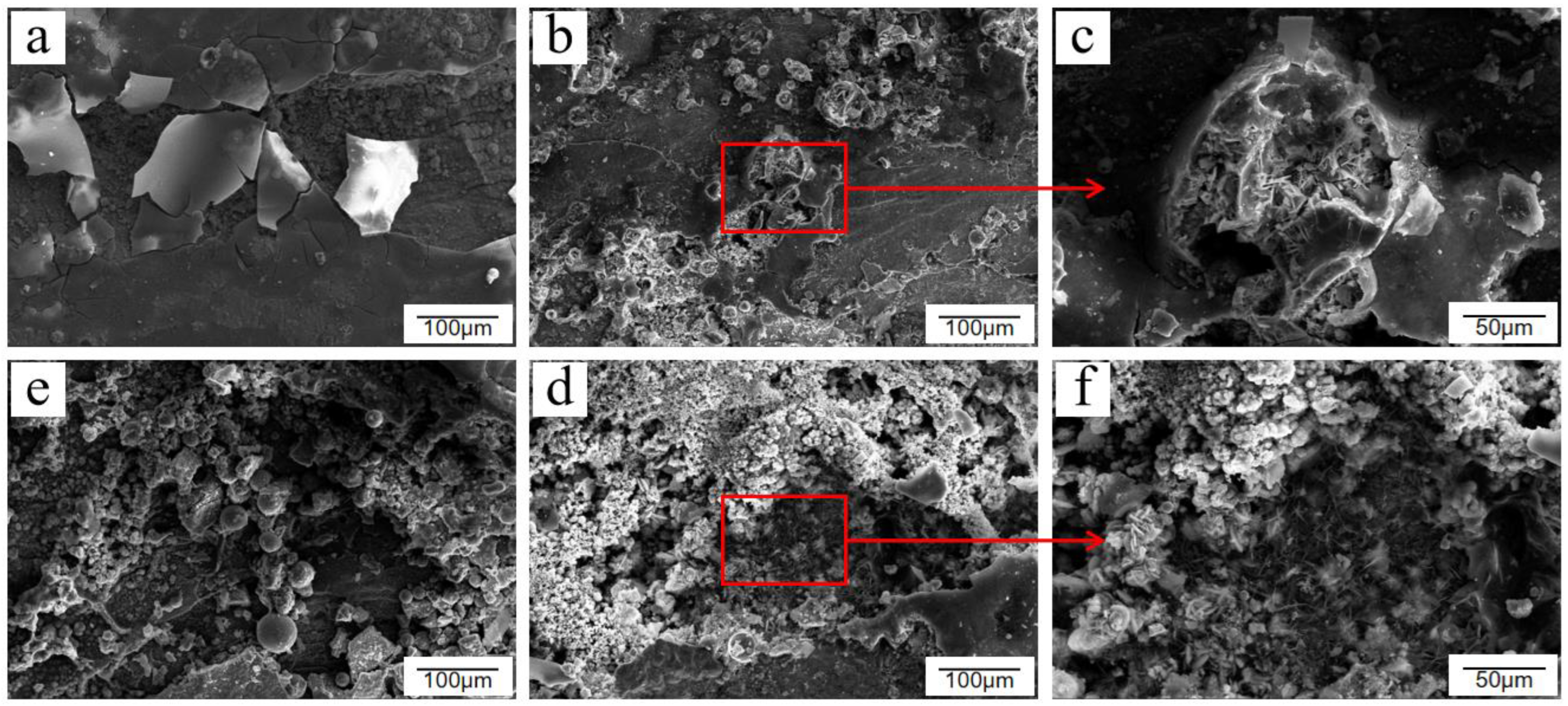

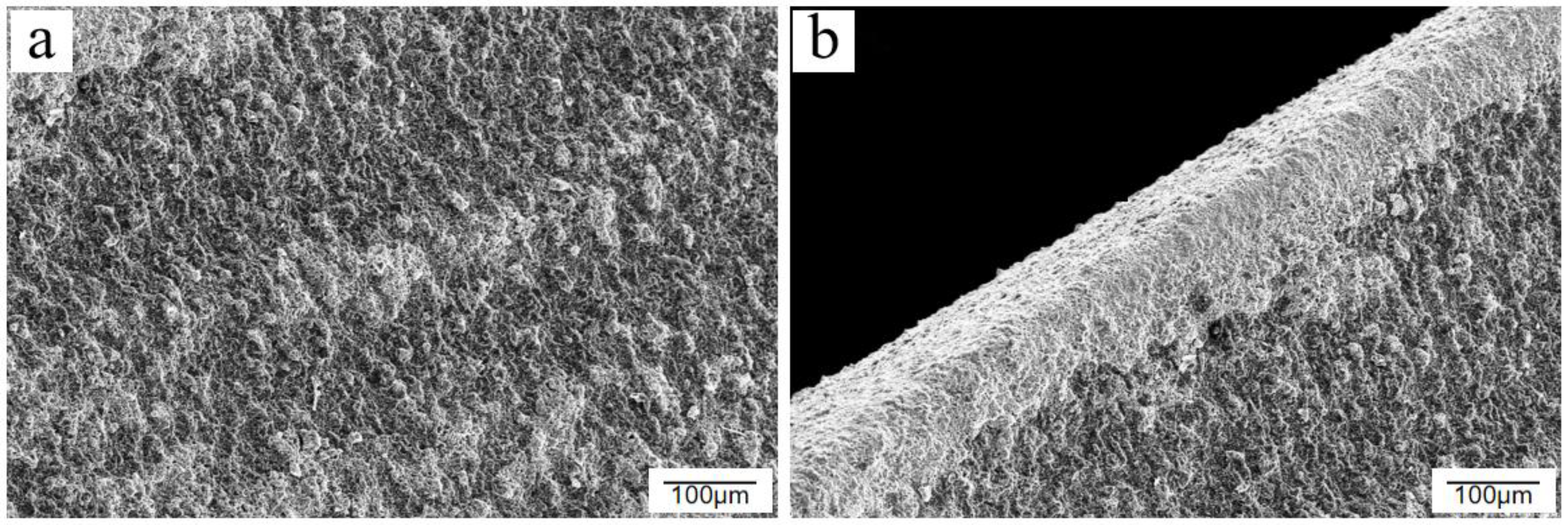
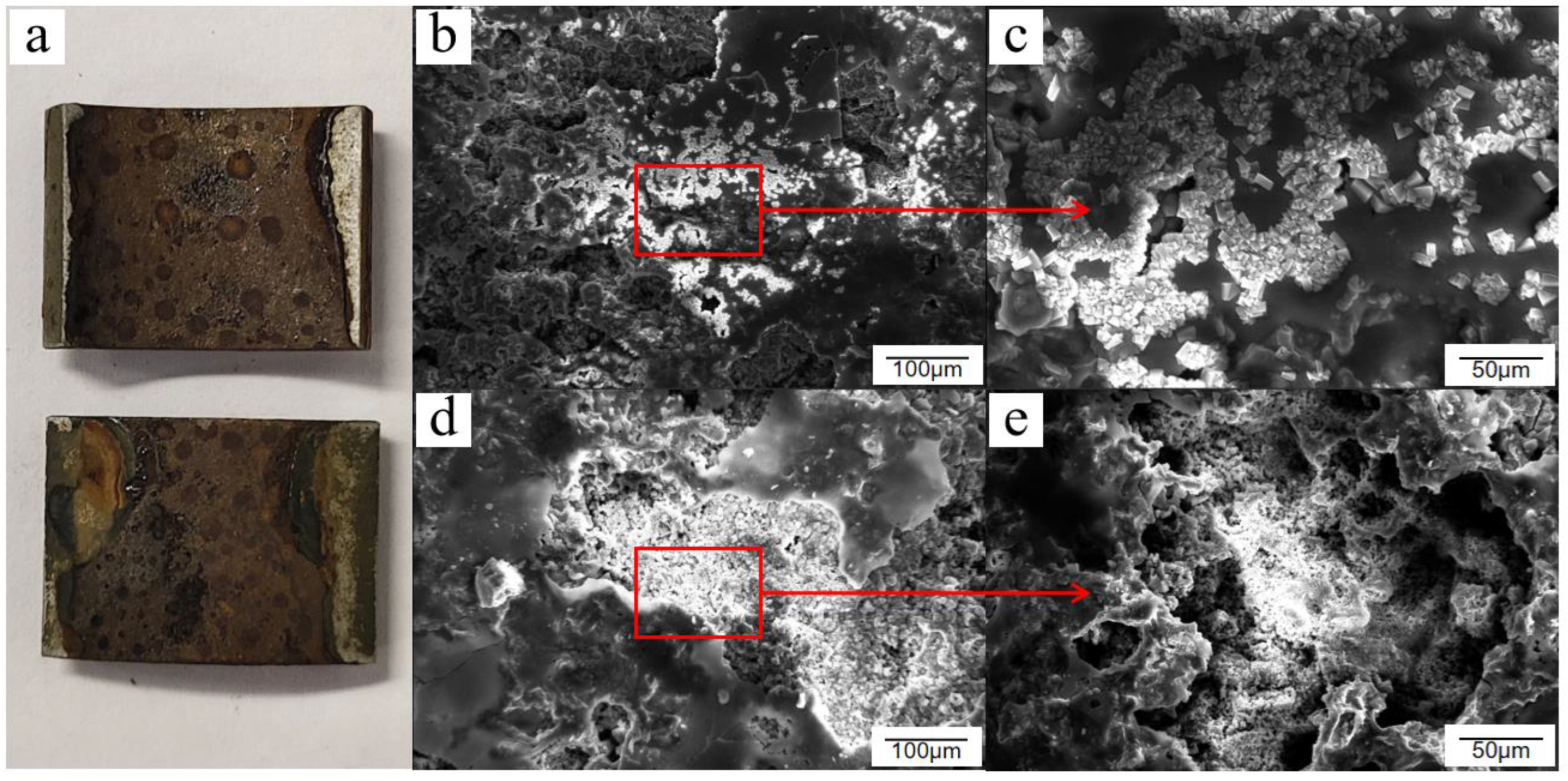
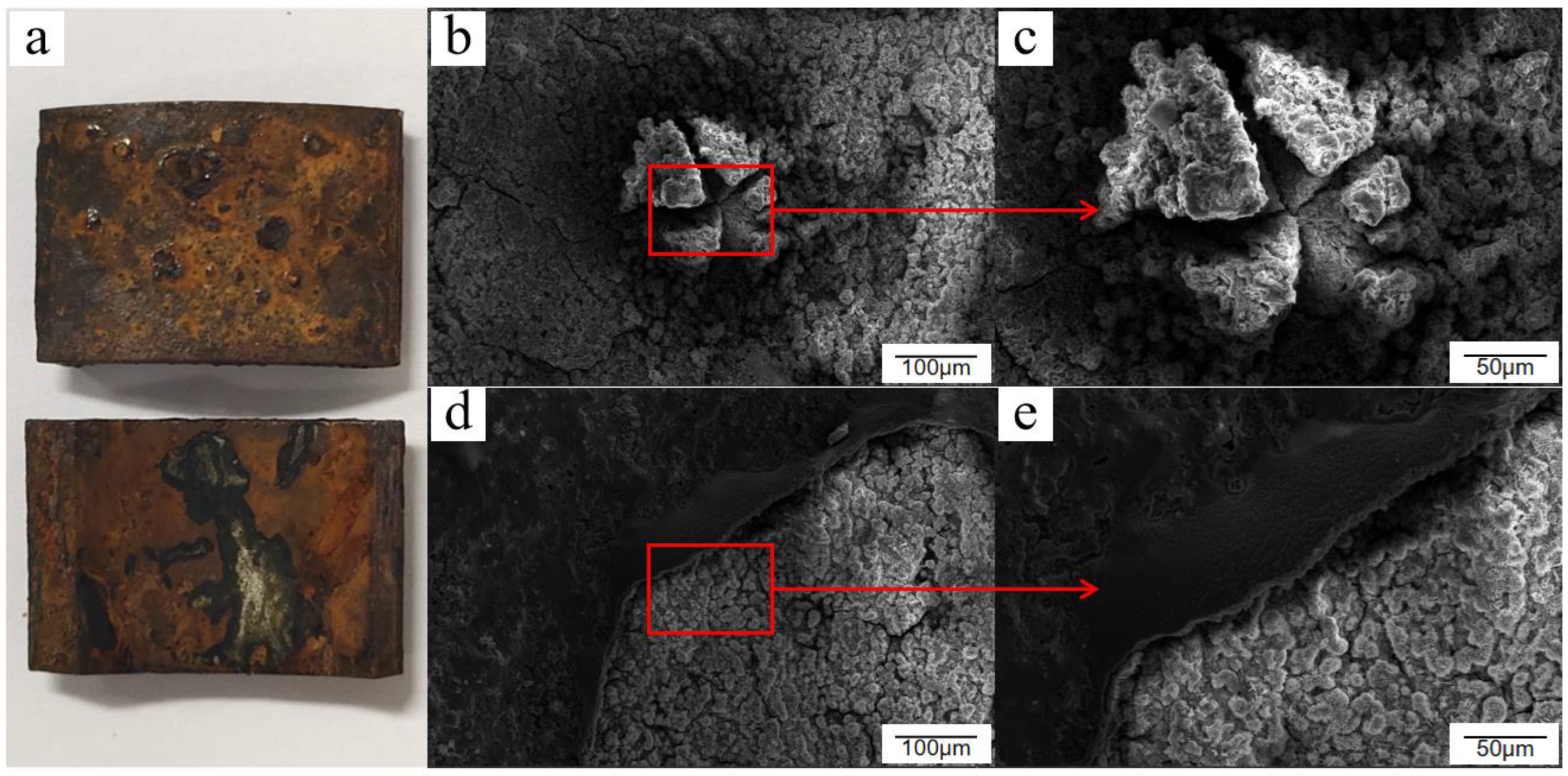
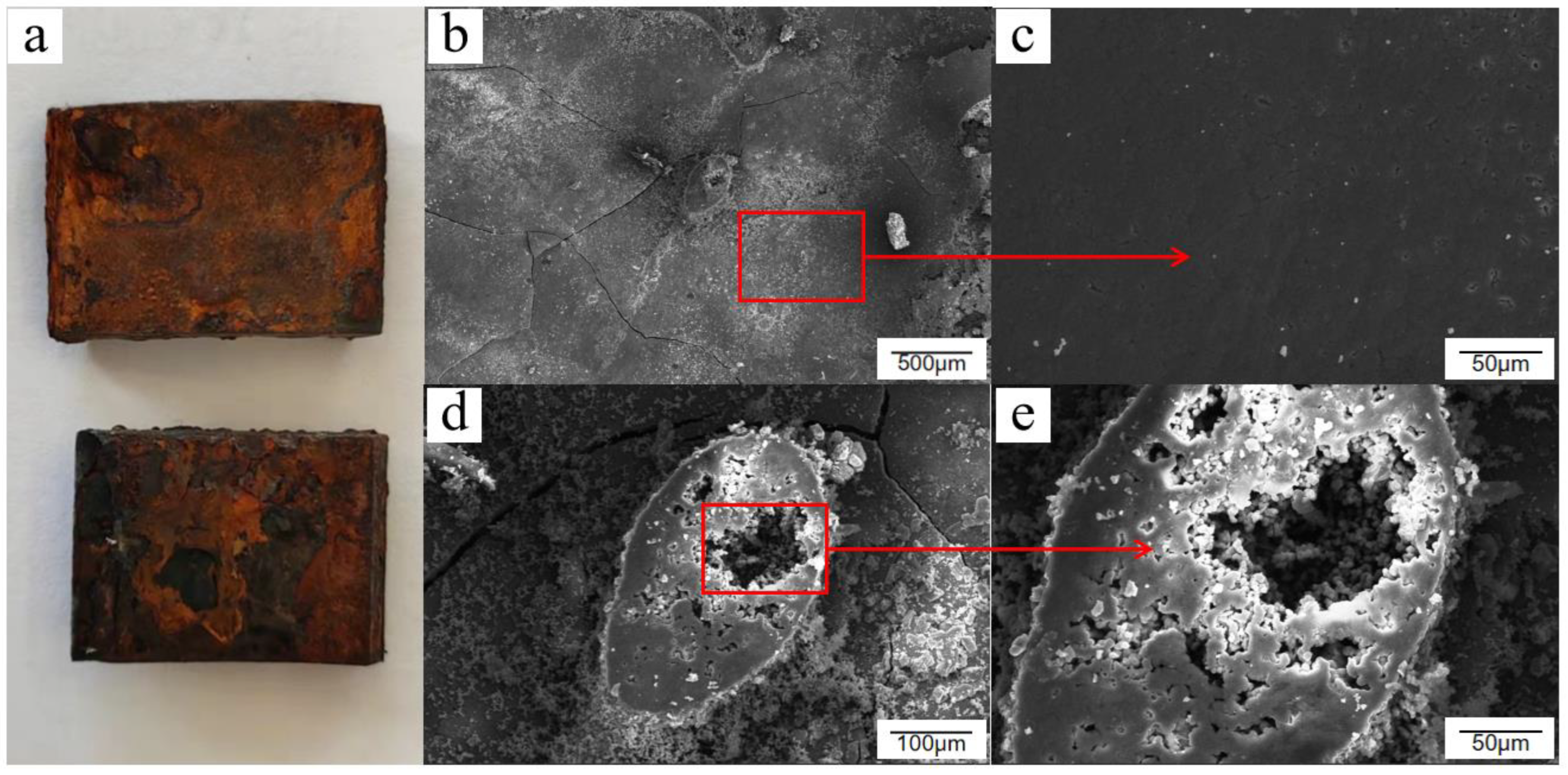


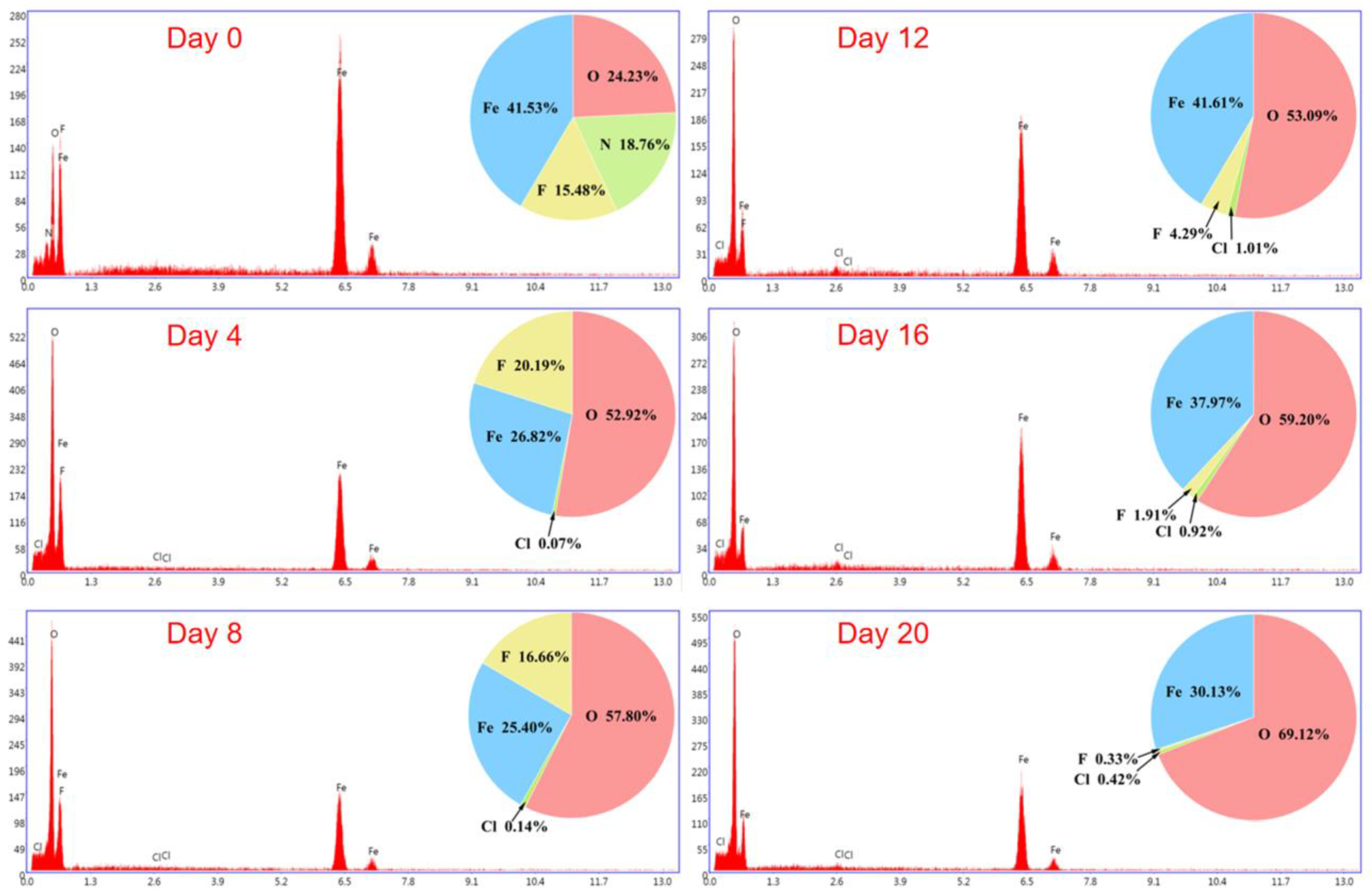



| Steel Model | Chemical Element Content (%) | ||||
|---|---|---|---|---|---|
| C | Si | Mn | P | S | |
| Q235A | 0.22 | 0.35 | 1.40 | 0.045 | 0.050 |
| Q235B | 0.20 | 0.35 | 1.40 | 0.045 | 0.045 |
| Exposure Period | Fitting Method | A | n | R2 |
|---|---|---|---|---|
| 4–20 days | Power function | 0.028 | 1.416 | 0.976 |
Publisher’s Note: MDPI stays neutral with regard to jurisdictional claims in published maps and institutional affiliations. |
© 2022 by the authors. Licensee MDPI, Basel, Switzerland. This article is an open access article distributed under the terms and conditions of the Creative Commons Attribution (CC BY) license (https://creativecommons.org/licenses/by/4.0/).
Share and Cite
Cai, S.; Ji, H.; Zhu, F.; Pei, W.; Xiao, W.; Tang, X. Research on the Corrosion Behavior of Q235 Pipeline Steel in an Atmospheric Environment through Experiment. Materials 2022, 15, 6502. https://doi.org/10.3390/ma15186502
Cai S, Ji H, Zhu F, Pei W, Xiao W, Tang X. Research on the Corrosion Behavior of Q235 Pipeline Steel in an Atmospheric Environment through Experiment. Materials. 2022; 15(18):6502. https://doi.org/10.3390/ma15186502
Chicago/Turabian StyleCai, Shuo, Hongchao Ji, Fengyun Zhu, Weichi Pei, Wenchao Xiao, and Xuefeng Tang. 2022. "Research on the Corrosion Behavior of Q235 Pipeline Steel in an Atmospheric Environment through Experiment" Materials 15, no. 18: 6502. https://doi.org/10.3390/ma15186502
APA StyleCai, S., Ji, H., Zhu, F., Pei, W., Xiao, W., & Tang, X. (2022). Research on the Corrosion Behavior of Q235 Pipeline Steel in an Atmospheric Environment through Experiment. Materials, 15(18), 6502. https://doi.org/10.3390/ma15186502








